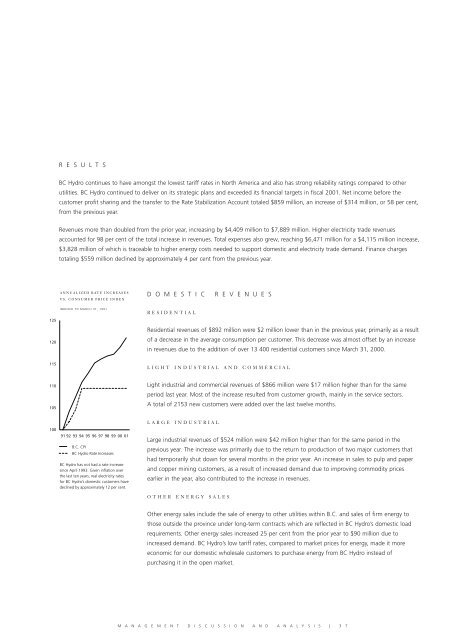BC Hydro Annual Report 2001
BC Hydro Annual Report 2001
BC Hydro Annual Report 2001
You also want an ePaper? Increase the reach of your titles
YUMPU automatically turns print PDFs into web optimized ePapers that Google loves.
125<br />
120<br />
115<br />
110<br />
105<br />
R E S U L T S<br />
<strong>BC</strong> <strong>Hydro</strong> continues to have amongst the lowest tariff rates in North America and also has strong reliability ratings compared to other<br />
utilities. <strong>BC</strong> <strong>Hydro</strong> continued to deliver on its strategic plans and exceeded its financial targets in fiscal <strong>2001</strong>. Net income before the<br />
customer profit sharing and the transfer to the Rate Stabilization Account totaled $859 million, an increase of $314 million, or 58 per cent,<br />
from the previous year.<br />
Revenues more than doubled from the prior year, increasing by $4,409 million to $7,889 million. Higher electricity trade revenues<br />
accounted for 98 per cent of the total increase in revenues. Total expenses also grew, reaching $6,471 million for a $4,115 million increase,<br />
$3,828 million of which is traceable to higher energy costs needed to support domestic and electricity trade demand. Finance charges<br />
totaling $559 million declined by approximately 4 per cent from the previous year.<br />
ANNUALIZED RATE INCREASES<br />
VS. CONSUMER PRICE INDEX<br />
INDEXED TO MARCH 31, 1991<br />
100<br />
91 92 93 94 95 96 97 98 99 00 01<br />
B.C. CPI<br />
<strong>BC</strong> <strong>Hydro</strong> Rate Increases<br />
<strong>BC</strong> <strong>Hydro</strong> has not had a rate increase<br />
since April 1993. Given inflation over<br />
the last ten years, real electricity rates<br />
for <strong>BC</strong> <strong>Hydro</strong>’s domestic customers have<br />
declined by approximately 12 per cent.<br />
D O M E S T I C R E V E N U E S<br />
RESIDENTIAL<br />
Residential revenues of $892 million were $2 million lower than in the previous year, primarily as a result<br />
of a decrease in the average consumption per customer. This decrease was almost offset by an increase<br />
in revenues due to the addition of over 13 400 residential customers since March 31, 2000.<br />
LIGHT INDUSTRIAL AND COMMERCIAL<br />
Light industrial and commercial revenues of $866 million were $17 million higher than for the same<br />
period last year. Most of the increase resulted from customer growth, mainly in the service sectors.<br />
A total of 2153 new customers were added over the last twelve months.<br />
LARGE INDUSTRIAL<br />
Large industrial revenues of $524 million were $42 million higher than for the same period in the<br />
previous year. The increase was primarily due to the return to production of two major customers that<br />
had temporarily shut down for several months in the prior year. An increase in sales to pulp and paper<br />
and copper mining customers, as a result of increased demand due to improving commodity prices<br />
earlier in the year, also contributed to the increase in revenues.<br />
OTHER ENERGY SALES<br />
Other energy sales include the sale of energy to other utilities within B.C. and sales of firm energy to<br />
those outside the province under long-term contracts which are reflected in <strong>BC</strong> <strong>Hydro</strong>’s domestic load<br />
requirements. Other energy sales increased 25 per cent from the prior year to $90 million due to<br />
increased demand. <strong>BC</strong> <strong>Hydro</strong>’s low tariff rates, compared to market prices for energy, made it more<br />
economic for our domestic wholesale customers to purchase energy from <strong>BC</strong> <strong>Hydro</strong> instead of<br />
purchasing it in the open market.<br />
M A N A G E M E N T D I S C U S S I O N A N D A N A L Y S I S | 3 7
















